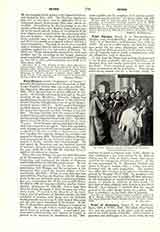

Peter Mongus (Greek: moggos, “stammerer”, or “hoarse”), intruded Monophysite patriarch of Alexandria (d. 490). Under Timothy Ailuros, who was made patriarch by the Egyptian Monophysites after Chalcedon (454-460), Peter Mongus was an ardent adherent of that party. As Timothy’s deacon he took part in the persecution of the Melchites. Timothy Ailuros was expelled from the patriarchal throne in 460 and the orthodox Timothy Salophakiolos was set up by the government instead (460-75). In 475 another revolution recalled Ailuros, who held his place till death (477). His party thereupon elected Peter Mongus to succeed him. The Emperor Zeno (474-91) sentenced Mongus to death; he escaped by flight. Meanwhile Salophakiolos returned and reigned till his death (481). The Melchites chose John Talaia to succeed (481-82: see John Talaia). Peter Mongus, always claiming to be patriarch, now comes forward again. John had quarrelled with Acacius, patriarch of Constantinople, and refused to sign Zeno’s Henoticon (482; see Henoticon); so he was expelled, the emperor changed his attitude, and supported Mongus (482). Talaia fled to Rome, Mongus took possession of the see, and sent notice of his succession to Rome, Antioch, and Constantinople. He had signed the Henoticon and was therefore inserted in Acacius’s diptychs as Patriarch of Alexandria. But the pope (Felix II or III, 483-92) defended Talaia’s rights in two letters to Acacius.
From this time Mongus became the chief champion of all Monophysites. He held a synod to condemn Chalcedon, and desecrated the tombs of Proterios and Salophakiolos, his Melchite predecessors. He was excommunicated repeatedly by the pope. It was communion with Mongus and the acceptance of the Henotikon that caused the Acacian schism of Constantinople (484-519). When Acacius died and was succeeded by Flavitas (or Fravitas, 489-90) Mongus wrote to the new patriarch again condemning Chalcedon and encouraging him in his schism with Rome. He died in 490 and was succeeded by another Monophysite, Athanasius II (490-96). For a long time after his death the name of Peter Mongus was still a party word. To read it in the diptychs (of the dead) was a kind of profession of Monophysitism; the first condition of reunion with Rome and the Catholic world generally was to erase it, with that of Dioscurus and the other great champions of the heresy. In the line of Alexandrine patriarchs Mongus is counted as Peter III. He is said to have written many books, of which however nothing remains. A pretended correspondence between him and Acacius (in Coptic) is proved to be spurious by Amelineau in the “Memoires publics’ par les membres de la mission archeologique francaise au Caire”, IV (Paris, 1888), 196-228.
ADRIAN FORTESCUE

